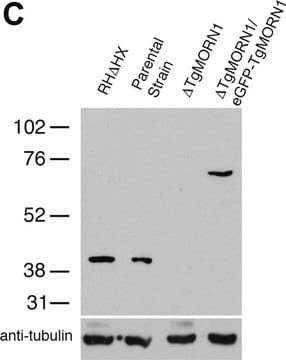The immunogen for Monoclonal Anti-α-Tubulin antibody produced in mouse, clone DM1A is microtubules from chicken embryo brain. This antibody recognizes an epitope located at the C-terminal end of the α-tubulin isoform (amino acids 426-430) as noted in the following references:Breitling, F., and Little, M., J. Molec. Biol., 189, 367-370 (1986).Wolff, A., et al., Biol. Cell, 63, 319-326 (1988).Serrano, L., et al., Anal. Biochem., 159, 253-259 (1986).
F2168
Anticorps monoclonal anti-α-tubuline
clone DM1A, purified from hybridoma cell culture
Synonyme(s) :
Monoclonal Anti-α-Tubulin
Sélectionner une taille de conditionnement
740,00 $
Sélectionner une taille de conditionnement
About This Item
740,00 $
Produits recommandés
Source biologique
mouse
Conjugué
FITC conjugate
Forme d'anticorps
purified immunoglobulin
Type de produit anticorps
primary antibodies
Clone
DM1A, monoclonal
Forme
buffered aqueous solution
Poids mol.
antigen ~50 kDa
Espèces réactives
yeast, mouse, amphibian, human, rat, chicken, fungi, bovine
Conditions de stockage
protect from light
Technique(s)
direct immunofluorescence: 1:50 using cultured BHK cells
Isotype
IgG1
Numéro d'accès UniProt
Application(s)
research pathology
Conditions d'expédition
dry ice
Température de stockage
−20°C
Modification post-traductionnelle de la cible
unmodified
Informations sur le gène
human ... TUBA4A(7277)
mouse ... Tuba1a(22142)
rat ... Tuba1a(64158)
Vous recherchez des produits similaires ? Visite Guide de comparaison des produits
Description générale
Monoclonal Anti-α-Tubulin (mouse IgG1 isotype) is derived from the DM1A hybridoma produced by the fusion of mouse myeloma cells and splenocytes from immunized BALB/c mice. Purified chick brain microtubules were used as immunogen. The isotype is determined by a double diffusion immunoassay using Mouse Monoclonal Antibody Isotyping Reagents, Product Number ISO2. The product is Protein A purified Monoclonal Anti-α-Tubulin antibody conjugated to fluorescein isothiocyanate, isomer I. It is purified by gel filtration and contains no detectable free FITC.
Spécificité
Immunogène
Application
- respiratory epithelium tissue in a study to determine the tubulin expression in the mice cilia
- breast cancer tissue sections to study the effect of LMO4 on the centrosome amplification and mitotic spindle abnormalities
- spindle and chromosomes of oocytes
- detection of tubulin by immunofluorescence and confocal microscopy in lung carcinoma cell.
- immunofluorescent staining of microtubules in human embryos and mitotic spindles from spleen lymphoblast.
Actions biochimiques/physiologiques
Forme physique
Stockage et stabilité
Clause de non-responsabilité
Vous ne trouvez pas le bon produit ?
Essayez notre Outil de sélection de produits.
Code de la classe de stockage
12 - Non Combustible Liquids
Classe de danger pour l'eau (WGK)
nwg
Point d'éclair (°F)
Not applicable
Point d'éclair (°C)
Not applicable
Faites votre choix parmi les versions les plus récentes :
Certificats d'analyse (COA)
Vous ne trouvez pas la bonne version ?
Si vous avez besoin d'une version particulière, vous pouvez rechercher un certificat spécifique par le numéro de lot.
Déjà en possession de ce produit ?
Retrouvez la documentation relative aux produits que vous avez récemment achetés dans la Bibliothèque de documents.
Les clients ont également consulté
Articles
Microtubules of the eukaryotic cytoskeleton are composed of a heterodimer of α- and β-tubulin. In addition to α-and β-tubulin, several other tubulins have been identified, bringing the number of distinct tubulin classes to seven.
-
What is the immunogen for Monoclonal Anti-α-Tubulin antibody, clone DM1A?
1 answer-
Helpful?
-
-
What is the Department of Transportation shipping information for this product?
1 answer-
Transportation information can be found in Section 14 of the product's (M)SDS.To access the shipping information for this material, use the link on the product detail page for the product.
Helpful?
-
Active Filters
Notre équipe de scientifiques dispose d'une expérience dans tous les secteurs de la recherche, notamment en sciences de la vie, science des matériaux, synthèse chimique, chromatographie, analyse et dans de nombreux autres domaines..
Contacter notre Service technique














